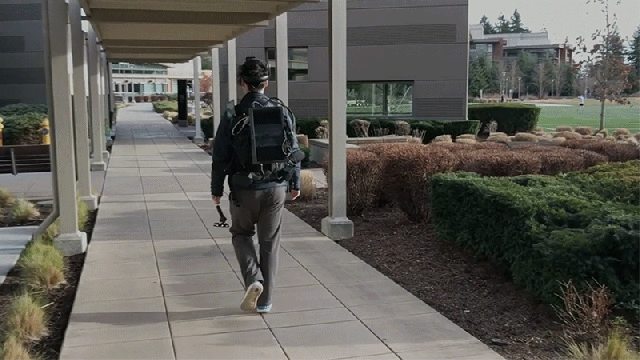Microsoft’s latest VR experiment is going to appeal to those who had to settle for living in a less than appealing neighbourhood to take advantage of cheap rent. Called DreamWalker, it’s a virtual reality rig that lets the user experience a completely different VR while they’re walking through the real one.
With smartphone-based VR on the way out, big companies like Microsoft, who’ve poured millions of dollars into researching and developing the technology, are still trying to find the “killer app” for VR; the one application that will make every consumer want to run out and buy the hardware. DreamWalker isn’t exactly that, but it’s an interesting use case that takes advantage of what VR does best: taking people somewhere else.
Before heading out for a stroll, the user provides a path planning software the route they’ll be taking, or their ultimate destination. The software then analyses an existing virtual world for a route that’s as similar as possible, to ensure minimal modifications have to be made to virtual streets, virtual buildings, or other rendered objects that exist in the virtual world of the user’s choosing — it doesn’t necessarily have to be another city.
Once that’s set, the user straps on a virtual reality rig that’s, admittedly, quite cumbersome given it’s still in the prototype stages, and because it includes a portable computer, virtual reality goggles, a pair of RGB depth cameras, GPS, and a smartphone providing a mobile data connection. As they walk in the real world, the wearer’s motions and movements are mirrored in the virtual world they’re experiencing.
The most obvious question that comes to mind is, in a big city setting, or really anywhere, how is the person wearing the VR rig going to avoid the random and ever-changing obstacles that exist in the real world that they can’t see?
That’s where the rig’s sensors and depth-sensing cameras come into play. In the example that plays out in this video demo of a virtual city, computer-generated pedestrians can be generated on the fly to represent people walking by in real life so they can be avoided in both the real and virtual worlds. And other real-life obstacles or safety hazards could be represented by various virtual objects that act as a safety barrier.
For example, a dangerously deep pothole in the real world could be covered up with a computer-generated car in the virtual world that a user knows not to try to walk through. Or freshly poured cement could be protected by a pack of yapping virtual dogs the user doesn’t want to get close to.
Different techniques could be used in the virtual world to protect users from hazards in the real world, without taking them out of the blissful virtual experience they’ve chosen. Although there’s one harsh dose of reality this VR system can’t hide using virtual reality tricks: the batteries dying on that giant rig.
